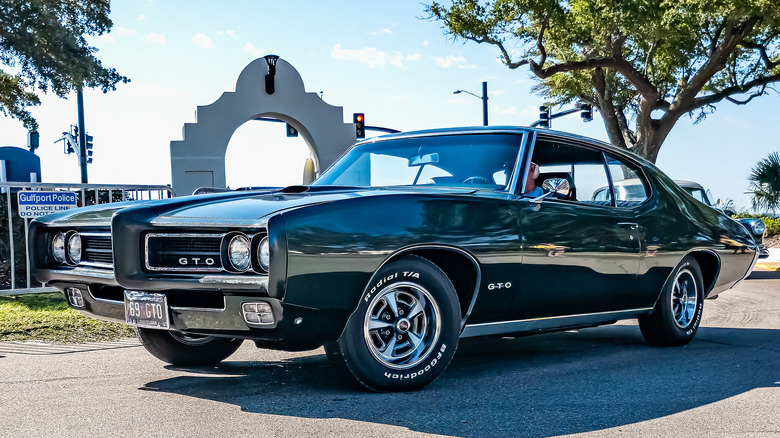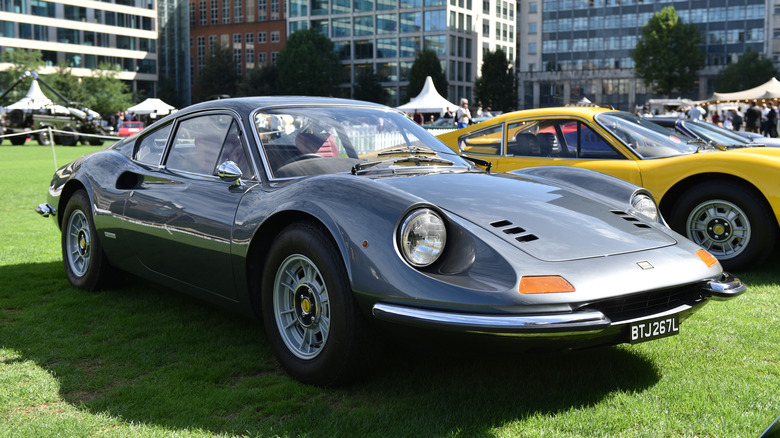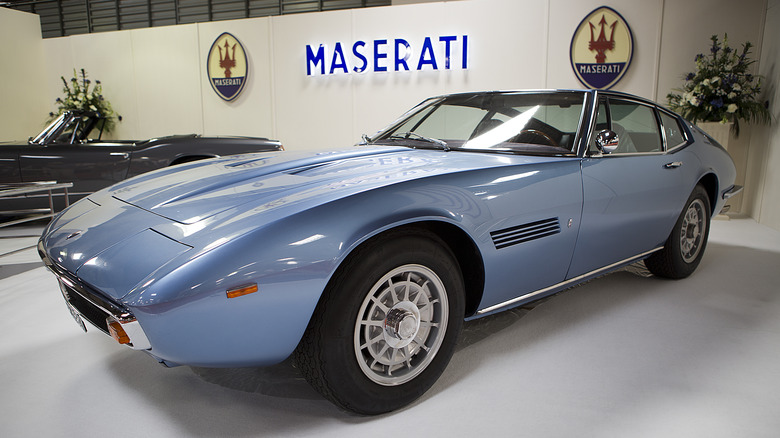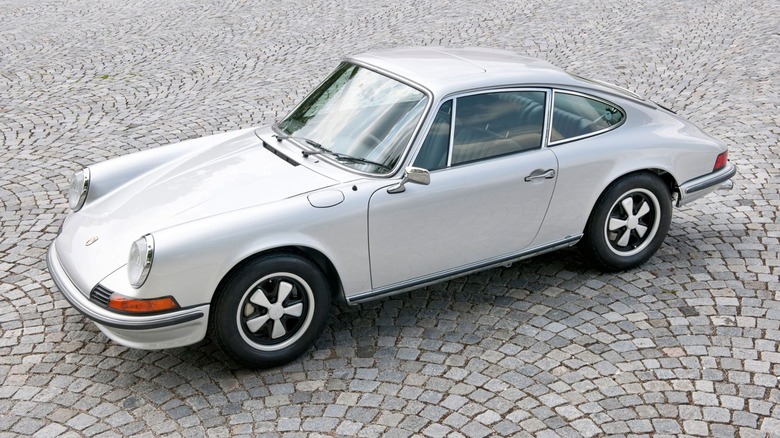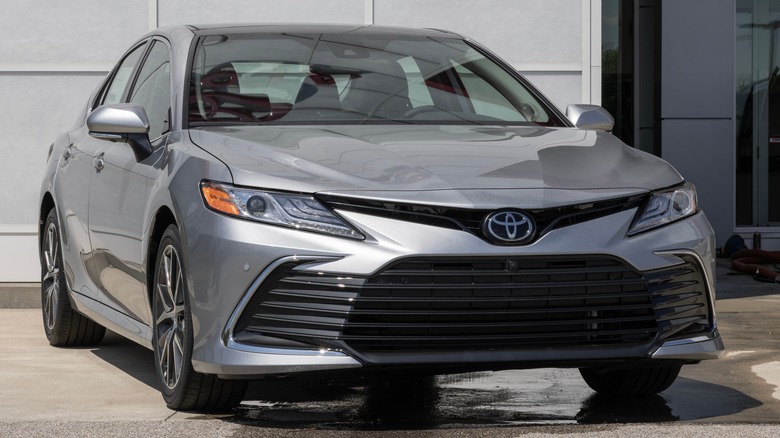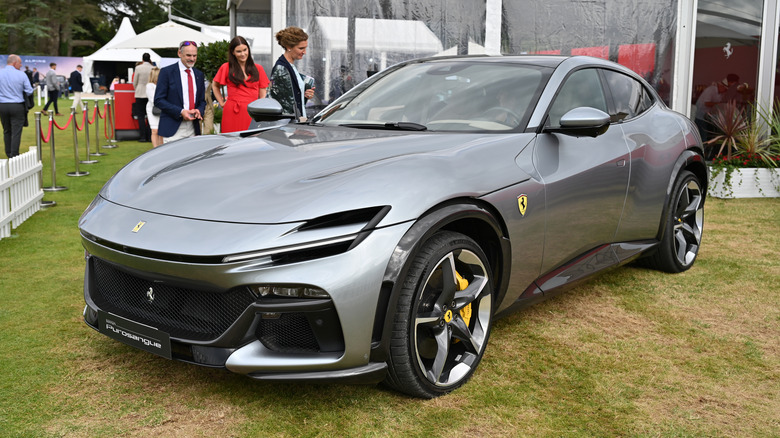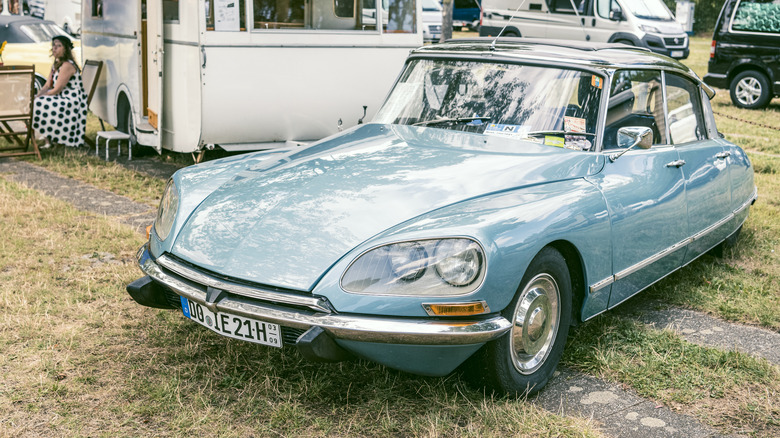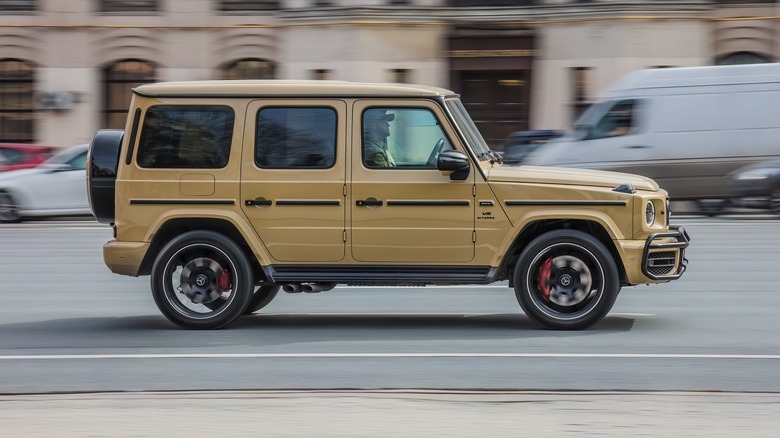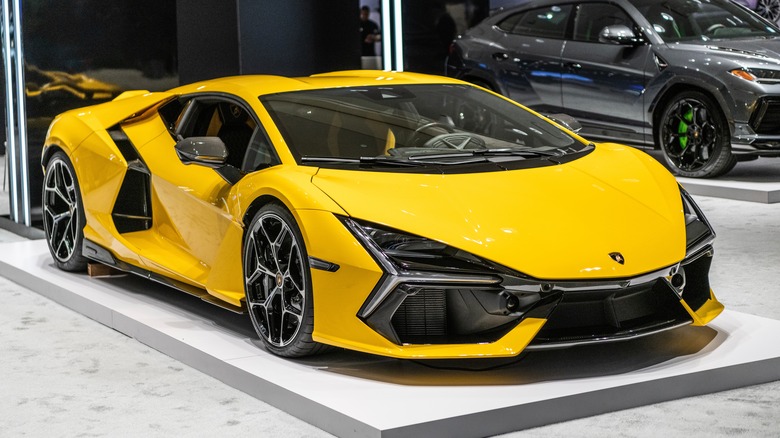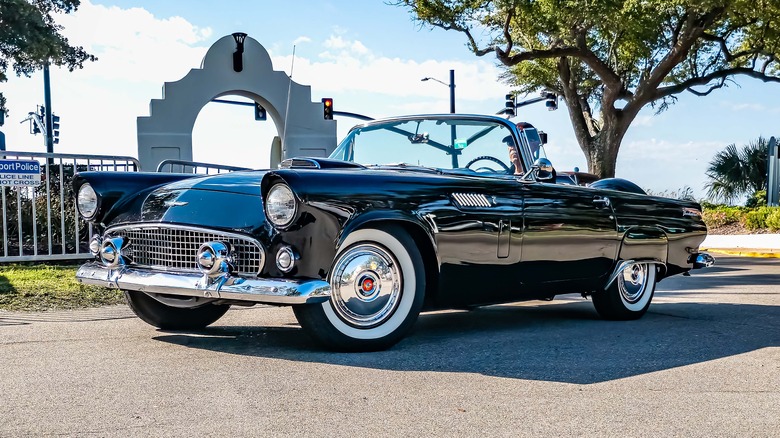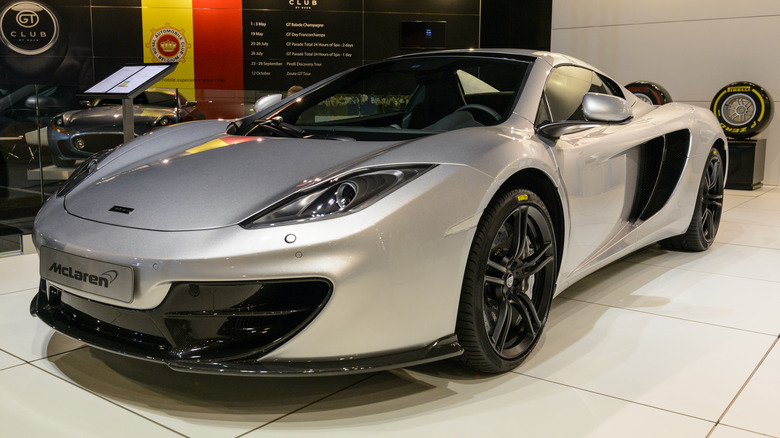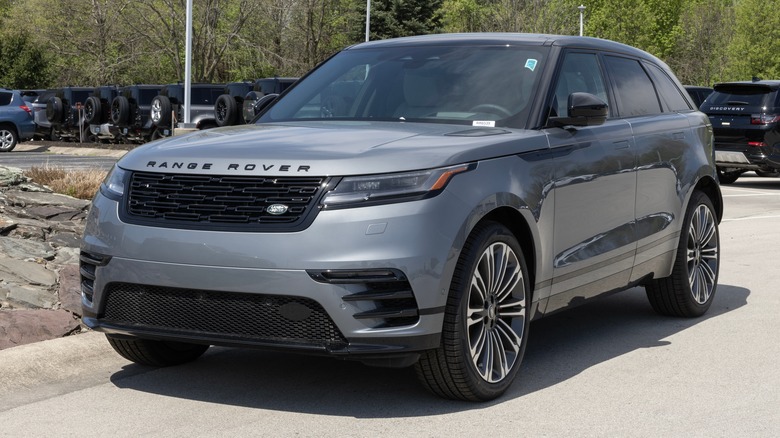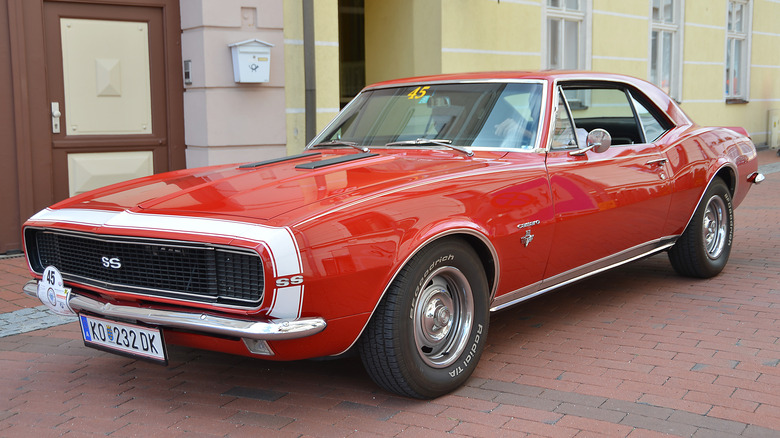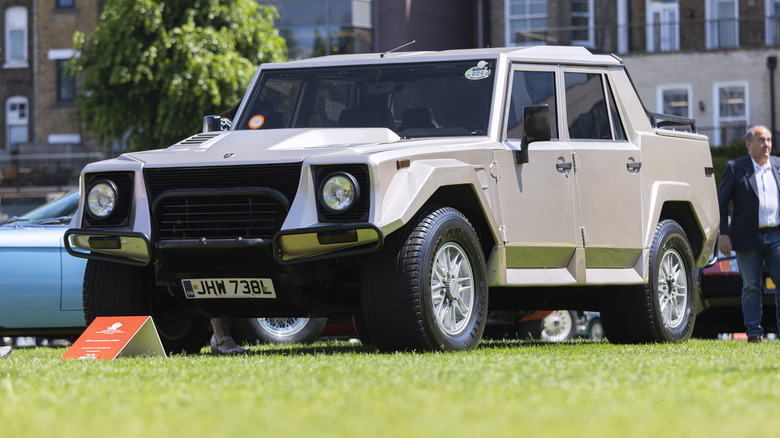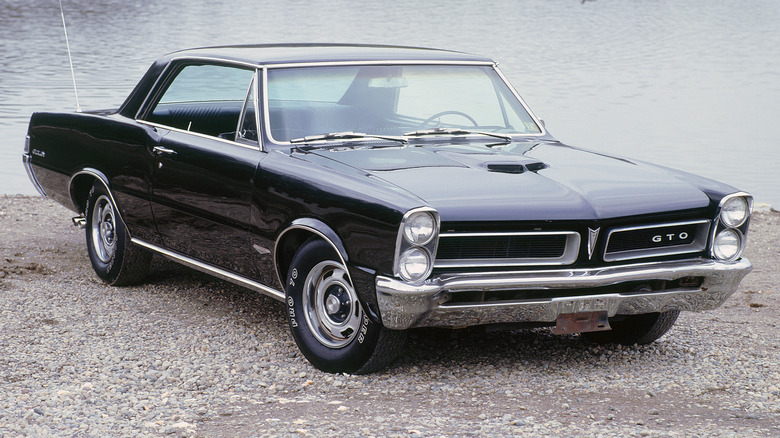Car Names That Have A Deeper Meaning Than You Think
Not every car name has to have a deep layer of meaning. Sometimes carmakers choose names simply because they sound good and fit the overall vibe of the car. Many are completely made up or loosely based on existing words, and even those cars that do take their names from real words and places don't necessarily make much sense. The Bentley Bentayga, for example, is named after a rock formation on the Spanish island of Gran Canaria. Why? Who knows. There's no obvious connection that links a luxury SUV and a famous pile of rocks, and Bentley has never offered any further explanation.
For all the Bentaygas of this world, however, there are an equal number of cars that do boast hidden layers of meaning in their names. Some allude to little-known facts about their respective histories, some are intended to make a statement about the cars themselves, and some are even sneakily stolen from other carmakers. These cars all feature names with more interesting backstories than most enthusiasts realize.
Ferrari Dino
Considered by many to be one of the best-looking Ferrari models ever designed, the Ferrari Dino was never intended to wear a Ferrari badge. In fact, most examples originally didn't, although plenty ended up with aftermarket Ferrari badges in the decades after they left the factory. Instead, the Dino was originally designed to be a separate brand of mid-engine road cars with less powerful engines, albeit built on the same production line as V12 Ferraris.
The Dino brand was named after the V6 engine which sat under its elegant bodywork, which was in turn named after its co-designer, Alfredo "Dino" Ferrari. Dino was Enzo's son and an engineer at his father's company, and he designed the engine that would eventually bear his name alongside Vittorio Jano, with whom Enzo had a decades-long working relationship. Tragically, Dino would pass away in 1956 at just 24 years old, but the engine he helped design would later be used in Ferrari's Formula 1 cars.
The engine was then adapted for use in the new mid-engine line of road cars, which were again named Dino in tribute to Enzo's late son. The Dino 206 and 246 were both sold solely under the Dino sub-brand, but Ferrari would switch to using Prancing Horse badging with the later Dino 308 GT/4.
Maserati Ghibli
Winds have proved a surprisingly popular source of naming inspiration for carmakers, with two, in particular, leaning heavily on the theme for many decades. Volkswagen is the most famous, with popular models like the Passat, Jetta, and Scirocco all named after various winds from around the globe. The other is Maserati, which first came up with the idea in the '60s with the Mistral. Since then, the brand has borrowed several more names from both oceanic and continental winds, like the Bora, Levante, and Ghibli. The latter is particularly notable as Ghibli has been used three times by Maserati for three very different cars.
Ghibli is the name of an Egyptian desert wind, and was originally used on the stunning Giugiaro-designed Ghibli grand tourer of 1967. The car was produced until 1972, and the name was then retired for two decades until the launch of the Biturbo Ghibli. The car's boxy look was a world away from its predecessor, but still managed to be closer in spirit than the third Ghibli, which launched in 2013. This latest Ghibli was designed to be a rival to the BMW 5 Series sedan, and European models offered an underwhelming 272 horsepower diesel engine as a base option. The car remains on sale through the 2024 model year, but it's being discontinued to make way for an upcoming Maserati EV.
Porsche 911
The Porsche 911 is one of the best-known sports cars ever built, and despite having to evolve considerably over the decades to adapt to a changing market, it has always managed to remain popular with enthusiasts. Sometimes, that popularity has even wrong-footed Porsche itself, with the company spending a fortune developing the all-new 928 as a 911 replacement in the '70s only for most customers to ignore it and keep buying the aging 911 regardless. Despite its status as a hallowed nameplate today, the 911 originally wore a different name. It was launched as the Porsche 901, but hastily changed after an objection from Peugeot.
The French carmaker claimed that it already owned the rights to the "x0x" numbering format — with its previous models including the 203, 403, and 404 – and so Porsche added a "1" as the middle digit instead of a "0". Thus, the 911 was born. Peugeot never ended up making a "901," but it did later use the "90x" nomenclature on a series of racing and concept cars including the 905 Group C racer and the V12-powered 907 supercar concept.
Toyota Camry
Unlike many other major manufacturers, Toyota doesn't follow a set naming strategy when launching new models, instead drawing inspiration from a wide variety of sources. Its best selling Camry sedan draws directly from its maker's Japanese heritage, with the name being an anglicized version of the Japanese word "kanmuri," which means "crown." Readers with extensive JDM knowledge might spot a strange similarity here — Toyota already had a sedan called the Crown, which it had sold in Japan since 1955.
By the time the Camry was introduced in Japan in 1980, the Crown was already a mainstay of Toyota's domestic lineup, and so to avoid confusion, Toyota wanted a thematically similar but visibly different name for its freshly-designed sedan. The Camry name was chosen and, thanks to its success in export markets like the United States, would eventually eclipse the Crown in global recognition. The Crown has continued to be successful in Japan over the decades, and in 2023, Toyota launched the latest generation Crown in the North American market.
Ferrari Purosangue
Ferrari spent many years telling everyone that it was never going to build an SUV. Even as recently as the 2016 Geneva Auto Show, the brand's CEO insisted in interviews that Ferrari would not follow the likes of Lamborghini, Aston Martin, and Bentley into the super-SUV segment. So, when the Purosangue was unveiled in 2022, it predictably caused many enthusiasts to collectively roll their eyes. Ferrari no doubt expected the controversy, and has made every effort since its launch to convince buyers and the public that it didn't simply cave in to market demand. This includes picking a name directly aimed at those who claim the car isn't a proper Ferrari.
According to a Ferrari press release, its first production four-door is "a peerless encapsulation of the Prancing Horse's iconic DNA." The name "Purosangue" translates from Italian as "thoroughbred," which Ferrari says it picked to reinforce the idea that this was in fact a true Ferrari in both name and nature. The brand also rather amusingly insists that the Purosangue isn't an SUV or crossover, despite also boasting about its "commanding driving position" and "the largest [trunk] ever seen on a Ferrari." The not-an-SUV proved hugely beneficial for Ferrari's bottom line, with orders temporarily paused in late 2022 as the waitlist for the car had already reached two years long.
Citroën DS
DS is now also the name of a luxury-oriented Citroën sub-brand sold across Europe, but the original Citroën DS was a groundbreaking family car with elegant looks and a ride that was unprecedentedly smooth. It was one of the most technologically advanced cars on the market at its launch in 1955, with hydro-pneumatic suspension, a semi-automatic transmission and fiberglass body panels to save weight. However, most of that technology wasn't immediately noticeable to passersby. Instead, what was noticeable was the car's low-slung appearance and classically appealing looks.
These looks were reflected in the car's name, with the DS initials chosen as they sounded like "déesse" in French, which translates as "goddess." The modern DS brand borrows its name from the Citroën DS, but doesn't acknowledge this initial wordplay, instead describing its name "as a symbol of daring and innovation." Perhaps modern DS wasn't confident that the looks of its latest cars could live up to the original's divine connotations.
Mercedes G-Class
Often referred to as the "G-Wagon," the Mercedes-Benz G-Class' original name at its launch in 1979 was Geländewagen. In typically straightforward German fashion, the name translates to English as "off-road vehicle." Quite literally, the SUV was the original "Mercedes-Benz off-road vehicle." It became the G-Class in 1993 to better line up with the brand's new naming convention, which also included the likes of the C-Class, E-Class, and more. However, the "G-Wagon" nickname always stuck, even after the name change.
The G-Class has retained its off-road capabilities over the decades, despite its shift towards the luxury market. 2025 will see the launch of one of the biggest changes for the model to date, with the first electric G-Class set to finally hit the market after years of rumors. Despite its unique powertrain, it's still very much a G-Class in both appearance and capability — and likely in price too, although as of this writing exact pricing hasn't yet been confirmed. That makes it more than worthy of wearing one of the most recognizable names in off-roading.
Lamborghini Revuelto
Most Lamborghinis are famously named after fighting bulls, and the Revuelto is no different. However, there are also some extra layers to the flagship hypercars' name that are worth unpicking. The particular bull that the Lamborghini is named after fought in the late 1800s and reportedly developed a reputation for jumping out of the arena and into grandstands. The word "revuelto" also has several meanings in Spanish, and can be translated as "mixed," "unsettled," or "rebellious," depending upon the context in which it's used.
It's been suggested that this could refer to the car's "mixed" hybrid powertrain, since it's the first Lamborghini flagship with both a V12 engine and an electric motor. Lamborghini's CEO also stated at launch that the car was "born to break the mold," reinforcing the idea of a car that would shake up Lamborghini's timeline. It's safe to say that the Revuelto is a milestone in Lamborghini history, not least because SlashGear's first drive of the car confirmed that it more than lives up to the high bar set by the Aventador.
Ford Thunderbird
Ford hasn't always gotten the naming strategy for its cars quite right. The Ford Probe of the '90s was a prime example — its pitch as a Mustang replacement didn't win over enthusiasts, and combined with its uncomfortable sounding name, it was never going to be a bestseller. Sales slumped and the car was eventually discontinued. The Thunderbird might have also suffered a similar fate a few decades earlier had it not been for a last-minute naming intervention from one of Ford's designers.
After an initial brainstorm that resulted in more than 5,000 potential names for the car being submitted, Ford's management team were stuck. The names put forward for the open-top sports car included Savile, Beaver, and Runabout, but it was decided that none of those names properly encapsulated the spirit of the car. In a last-ditch attempt to find a suitable name, one executive offered a new, top of the line suit to any employee who could come up with something better.
One designer, Alden Giberson, eventually pitched a name that fitted the bill: Thunderbird. Various claims have been made as to where Giberson got the name from — some reports say it was directly from Native American folklore, while others claim it was inspired by the wealthy district of Thunderbird Heights in California. Either way, it proved to be the bright idea that Ford needed, and the Thunderbird was launched with its new name in 1955.
McLaren MP4-12C
It's hardly the catchiest of names, but there's a good reason why McLaren's first road car since the F1 was called the MP4-12C. In fact, the brand itself handily broke down each aspect of the car's name at its launch. The "MP4" designation is an historic one, having been given to McLaren's Formula 1 cars since the '80s. It was originally coined to reflect the merging of McLaren and its owner Ron Dennis' other outfit, Project 4 Racing, being an abbreviation of "McLaren Project 4."
The second part of the car's name was also carefully chosen. McLaren has developed a secretive "Vehicle Performance Index" as a means of measuring the overall performance of both its own and its rivals' cars. The MP4-12C apparently scored a "12" rating on this index, and so that was reflected in its name. Lastly, the "C" in the name stands for carbon fiber, which is heavily used in the car's construction, including in its monocoque chassis. It might all make sense when dissected, but the name was still a mouthful for buyers and journalists to remember. As a result, the brand often uses the shortened name "McLaren 12C" when referring to the car today.
Range Rover Velar
Slotting in between the Evoque and the Sport in the Range Rover lineup, the Range Rover Velar is a relatively recent addition to the brand's dealerships, having been first unveiled in 2017. However, its name goes back much further to the earliest days of the Range Rover. It's named after the original Range Rover prototype of 1969, which was built in secret and initially wore "Velar" badging while undergoing testing to disguise its origins.
The name was derived from the Italian word "velare," which translates as "to veil" or "to cover." After less than a year of testing, the covers were taken off the car and the Range Rover was revealed with its intended name. It proved to be a defining vehicle in its segment, setting a blueprint that modern Range Rover vehicles continue to follow decades later. The Velar moniker wasn't used again until it was brought back for the 2017 SUV, which remains in production today.
Chevrolet Camaro
The Chevrolet Camaro was GM's response to the Ford Mustang, and it was a rushed one at that. After seeing the immediate sales success of the Ford, GM bosses demanded that Chevy create a rival at short notice, based on one of the brand's existing platforms and with as many shared parts as possible. The resulting car wasn't satisfactory for certain top brass at the company, but it was pushed into production anyway, and proved a big hit with buyers. It would eventually go on to become one of the company's best loved nameplates, trailing only the Corvette.
Much like the rest of the car, its nameplate was hurriedly created as Chevy scrambled to get it to dealerships. The name has been claimed to be derived from a French slang term meaning "comrade" or "friend," although its definitive origins aren't known. At launch, however, a Chevy manager told the press that the "Camaro is a small, vicious animal that eats Mustangs." Fighting words no doubt, but words that might have made more sense had Chevy chosen to adopt the car's originally planned name, the Panther. Either way, the launch formed a rivalry between Ford and Chevy that continued until Chevy retired the Camaro in early 2024.
Lamborghini LM002
Lamborghini's first production SUV is often referred to as the "Rambo Lambo," but it was officially designated the LM002. The acronym stood for "Lamborghini Militaria 002," but despite the name, it was not the brand's second military-oriented vehicle. In fact, it was the third, with the Cheetah and LM001 prototypes preceding it. However, the LM002 was the first Lamborghini off-roader to make it to production.
The original Cheetah prototype was unveiled to much fanfare in 1977, but things quickly went south after a rival military contractor that alleged Lamborghini had ripped off its design. As a result, the Cheetah was shelved, likely a tacit admission from Lambo that the there was some truth to the allegations. The LM001 was unveiled several years later, sporting a new design similar to that of the future LM002, but only ever remained a concept. It would take until 1987 for the production LM002 to launch, a decade after Lamborghini unveiled its first military design.
Given the embarrassment that the Cheetah's stolen design allegations had caused Lamborghini, it's understandable that the brand wanted to wipe the slate clean with its next off-road concept. That's likely why it was designated the LM001 despite being the second iteration of the SUV design, and as a result, why the following production SUV became the LM002.
Pontiac GTO
Today, the original Pontiac GTO is one of the brand's most collectible cars, but it nearly never got built. GM had enacted an engine size restriction on midsize cars prior to the GTO's release, with the intention of discouraging its brands to make racing-oriented vehicles. However, a freshly-installed Pontiac executive called John DeLorean was having none of that, and proposed a workaround to ensure buyers could still get a car with a race-ready engine. He suggested Pontiac launch a high performance options package for the Tempest with a larger, more powerful engine, and in doing so, he kickstarted the golden age of the muscle car.
DeLorean wanted a name for the new options package that would reflect its performance intentions, and so decided to borrow from an unlikely source: Ferrari. The Italian brand had garnered international attention for its racing successes with the 250 GTO, and so DeLorean decided to simply steal the "GTO" name for his new Pontiac. In Italian, the acronym stands for "gran turismo omologato," which translates as "grand touring homologated."
The Pontiac GTO was neither a homologated race car at the time of its launch, nor was it a true grand tourer, but DeLorean chose it anyway for its exotic-sounding nature. His creation proved a huge hit, to the point where GM was forced to scrap its engine size cap and introduce the GTO as a standalone Pontiac model.
